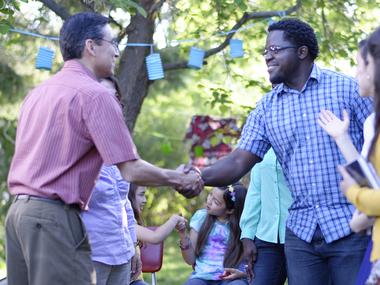From poverty to drug abuse to unemployment and other challenges, social problems include a variety of ills that damage society from the inside out. Our communities and churches cannot thrive if such problems are unknown or ignored. Of all groups, it is the religious — those motivated not just by a social conscience but also by a belief in the divinity of each person — who should be in the vanguard of lifting our neighbors’ burdens.
Interestingly, new Pew Research Center findings say the share of U.S. adults who think houses of worship contribute "not much" or "nothing" to solving important social problems has nearly doubled since 2001 (from 21 percent then to 39 percent today). Of those within the religious fold, 74 percent of weekly churchgoers say churches contribute "a great deal" or "some" to solving social problems, while 49 percent of those who attend less often agree.

While Pew’s report focused on what some think churches do, studies of what believers say they do (such as this one) indicate faith is the strongest predictor of generosity, altruism, trust and civic involvement among Americans. So why this gap between the perception of some and the experience of others? How can this gap be bridged, and whose responsibility is it to do that?
In part, this Pew report could simply be a reflection of a growing unawareness of religion. After all, the ranks of the religiously unaffiliated continue to rise, creating a sizeable chunk of U.S. adults (nearly 25 percent) who are likely unaware of the day-to-day happenings inside churches. But we know this isn’t the only possible cause because Pew’s finding also show that not even all regular churchgoers think their houses of worship are solving social problems.
Another reason for this gap could be rooted in respondents’ understanding of survey terminology. In the words of Martin E. Marty of the University of Chicago Divinity School:
What does “solving social problems” mean? Are the big ones “solvable,” or are they only “addressable”? Who really pictures the epochal refugee crises of our day as being “solvable”? Or the destructive human issues in “climate change”? And are any religious institutions capable of addressing the issues on such a vast scene that it is fair to ask thus about them?
These are important questions that don’t have clear answers. But they are valuable because they temper the kneejerk lamentations of those worried that so many are unaware of the good churches do in society. It’s one thing for people to perceive houses of worship as nothing more than places of preaching, where the power of the word doesn’t motivate the heart to other-oriented action. It would be quite another thing if that perception reflected reality.
Sharing Stories of Service
Churches can certainly help decrease the knowledge gap by publicizing their efforts to address social problems. Though such efforts risk appearing self-promotional, they also help foster a culture that values Christian service. What’s more, these efforts can forge invaluable partnerships between churches and humanitarian organizations that have a mutual interest in joining together to alleviate pain and suffering through serving others.
Journalists play a role as well because their reports can inform the unaware of the good churches are doing. Take, for example, a June story from North Carolina where several Christian congregations held a community-organizing camp for kids, teaching them "we’re all God’s children, and we all should look out for one another." Or a July report out of Georgia that tells how a Southern Baptist congregation rallied to help a Muslim neighbor whose business was robbed and damaged. “They stood by me in my difficult time, and it gives me hope to rise again,” the grateful business owner says.
Careful reporting also shows how the ripples of religious community extend beyond group service projects to the voluntary one-on-one interactions of the faithful. One example can be seen in a July in-depth profile in the New Yorker about one Christian woman's quest to answer God's call to be a hospice nurse. She chose this vocation because she wanted to "care for the whole person" — a desire rooted in her belief that "God had created bodies for a reason and that they mattered a lot." This kind of quiet one-on-one ministry happens every day by unseen multitudes who quietly live for God without need of recognition.
Practicing What We Preach
Of course, even the best reporting can’t completely fill the knowledge gap. And the most diligent efforts of churches to tell the world their service stories will not reach or convince everyone. So perhaps the most important thing people of faith can do, regardless of others’ false perceptions, is to live their religion, ever seeking to relieve their neighbors’ burdens, motivated by a commitment to a God who “calls for sacrificial love, not benign whatever-ism.”[1]
This matters because, as Marty writes, “when churches and synagogues are not only observed and reported on as losing heart or finding other priorities than the ‘social’ ones, but actually failing and falling, millions get hurt” (emphasis added). Thus, he says, “attending to these local and voluntary fronts is, in dated language, ‘where the action is.’ On some scales, some problems, if not solved, are there addressed, and the ‘social’ scene and the people who make it up experience life enhanced.”
[1] Kenda Creasy Dean, Almost Christian, 37.